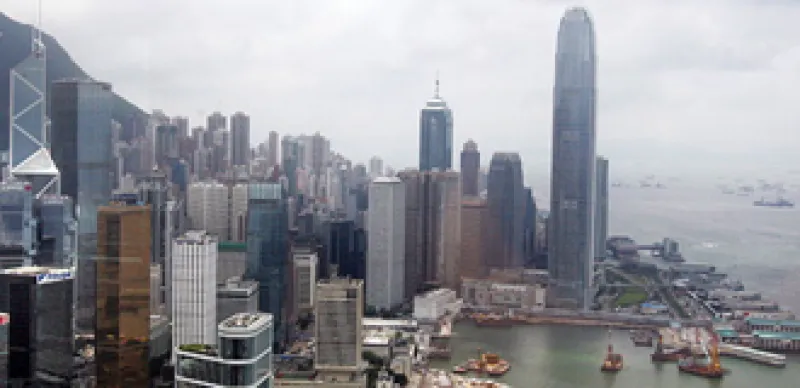Asia’s stock markets fell even further as a result of the financial crisis than developed markets in Europe and the U.S., so it seems only fitting that they have risen higher as economic recovery has taken hold across the region. China’s benchmark Shanghai Stock Exchange composite index, for example, plunged 65.4 percent in 2008, only to soar by 80 percent in 2009. Even so, these eye-popping gains are eclipsed by Indonesia, whose broad market rocketed 87 percent last year.
[Click here to see the complete ranking for the 2010 All-Asia Research Team.]
“It’s a fantastic time,” cheers Hua He, Nomura’s Hong Kong–based head of equity and fixed-income research for Asia ex-Japan.
Not surprisingly, in the light of such dynamic growth, investors are clamoring for research, and banks are eager to provide it — in many cases adding analysts and expanding coverage to keep pace with soaring demand.
“There are more firms taking Asia seriously, and there is a tougher competitive climate in the last six to 12 months,” observes Hong Kong–based Brent Robinson, who last July replaced Adrian Faure as head of Asia-Pacific investment research for Citi. Faure was promoted to Citi’s regional head of equities.
Credit Suisse outpaces the competition when it comes to providing coverage of postcrisis Asian markets, according to participants in the 2010 All-Asia Research Team, Institutional Investor’s 17th annual ranking of the region’s top equity analysts. The Swiss bank vaults all the way from fourth place to capture the No. 1 spot, picking up 28 total team positions, seven more than last year.
Citi, which held the top spot last year and shared it with J.P. Morgan the year before, ties for second place with Nomura, which catapults from No. 8. Citi and Nomura each win 25 positions.
Tied for fourth place, with 24 positions each, are J.P. Morgan and Morgan Stanley. The former was ranked third last year; the latter, eighth.
Ali Naqvi, Credit Suisse’s head of cash equities for Asia ex-Japan, says his firm resisted the temptation to scale back its research operations, as many other banks did in response to the global economic meltdown, and as a result was in a better position to capitalize on the inevitable rebound.
“We probably have the most experienced research team in the region,” says Naqvi, who is based in Hong Kong. “We are one of the very few Asia research teams that did not have to reduce materially. In fact, our head count was up last year, and it will go up again this year.” Credit Suisse currently has 90 equity analysts, up from 86 at this time last year. Those analysts cover 751 companies across Asia, 27 more than one year ago.
Citi did trim its operations in Asia, albeit only modestly. The firm has 67 analysts, compared with 71 last year, and they track 609 stocks, down from 628. “We remained very stable through the Asian economic crisis,” Robinson notes, adding that his researchers are backed by a wealth of experience. “Citi has been in Asia for more than a century.”
Nomura’s research operations got a huge boost after its parent company’s acquisition of the Asian and European units of Lehman Brothers Holdings following its September 2008 bankruptcy. The Japanese bank picked up some 1,500 Lehman employees in the deal, including He, who had served as Lehman’s head of equity and fixed-income research for Asia ex-Japan.
One of He’s tasks over the past year has been to consolidate his ex-Lehman and Nomura staffs, eliminating overlapping coverage and bolstering the firm’s equity research bench with new talent. From 43 analysts covering 296 stocks before the Lehman acquisition, Nomura now has 61 analysts covering 585 stocks in Asia ex-Japan.
Marcus Walsh, Morgan Stanley’s head of Asia-Pacific research, has overseen a veritable explosion of coverage in the past year. Although he added only four analysts, for a total of 116, his team now tracks a whopping 776 companies, 75 more than last year.
“There is staggering pent-up demand in China,” says Walsh, who is based in Hong Kong. By way of example he notes that there is a waiting list for cars on the Mainland, while in Europe and the U.S. auto sales have generally been sluggish. Demand in China — for autos and just about everything else — is fueling growth across Asia; Walsh predicts regional real gross domestic product growth of 9 percent this year, led by double-digit GDP growth in China.
The importance of China to Asia’s economic growth is reflected in the way Morgan Stanley structures its Economics team. Regional economist Chetan Ahya and Qing Wang, economist for Greater China, co-direct the 11-economist squad, which rises one rung to claim top honors for the first time. The team, with economists based in Hong Kong, Mumbai, Shanghai and Singapore, published a report last May declaring that the recovery in China’s property sector was real and sustainable and that it would also help boost private consumption. Since then the Chinese property sector had advanced 9.9 percent, through March, and consumer spending had increased 12.9 percent.
“It turned out that the recovery has indeed been very robust, helping deliver a V-shaped and sustainable recovery despite the phasing out of [the government’s] policy stimulus in the latter part of 2009 and into 2010,” explains Wang, 40, who earned a Ph.D. in economics at the University of Maryland and worked as an economist at the International Monetary Fund before becoming Bank of America Corp.’s head of economics and strategy for Greater China in 2005; he moved to Morgan Stanley in 2007.
That call was an extension of an earlier, controversial call the team made in September 2008. “The conventional wisdom in the market was that the Chinese property sector bubble had burst,” he recalls. “We argued that there had been no nationwide property price bubble and that the fundamentals of China’s property sector remained sound.”
The Morgan Stanley team began last year by telling clients that things would get worse before they got better: “Further growth deceleration is expected in the first half of 2009, and deflation is a distinct possibility,” the economists stated in their Outlook for 2009 report. “The effect of massive policy stimulus implemented since October 2008, together with a tepid recovery in G-3 economies, is expected to help the Chinese economy regain some growth momentum in the second half of 2009.”
The economists were actually more cautious than they needed to be. China’s economy, which grew only 6.2 percent year-over-year in the first quarter of 2009 — the slowest pace in a decade — jumped by 7.9 percent in the second quarter, according to China’s National Bureau of Statistics. It has been accelerating ever since: 9.1 percent in the third quarter, 10.7 percent in the fourth quarter and 11.9 percent in the first three months of this year.
“We expect China’s economy to deliver stronger, more balanced growth with muted inflationary pressures in 2010, featuring 10 percent GDP growth and 2.5 percent inflation,” the economists told clients in a November report, A Goldilocks Scenario in ’10. Those forecasts were based on the assumptions that strong domestic demand in 2009 would be sustained and recovery in G-3 economies would continue to be mild.
Not that the economists have focused exclusively on China. “Over the past year we’ve been bullish on Asia ex-Japan’s overall growth, and our team’s call, particularly for the top four economies in the region — India, China, [South] Korea and Indonesia — has worked well,” says Ahya, 41. “We turned bullish on India in May 2009, when we argued that the general elections outcome would ensure an improvement in the macro environment. Since then we have been upgrading growth estimates ahead of the Street, and India has been one of best-performing markets.”
The Indian National Congress Party was the big winner in the world’s largest democratic election, and it formed the basis of a new government under Prime Minister Manmohan Singh. Since the election results were announced on May 16, India’s broad market had gained 44 percent, through March.
Politics also influenced the team’s coverage of Indonesia. Changes to that nation’s election laws in 2008 mandated that candidates for president and vice president can be nominated only by parties or coalitions that win at least 20 percent of the 560 seats in the People’s Representative Council or that earn 25 percent of the national vote. Coalitions began to emerge following legislative elections in April 2009, signaling growing political stability, so “we made a big call arguing that Indonesia deserves to be added to the BRICs — Brazil, Russia, India and China,” says Ahya, who earned a master’s degree in public policy and management from the University of London in 2004 and was an economist at BNP Prime Peregrine before joining Morgan Stanley in 2000. “The key differentiating factor in our bullish call is the structural decline in the cost-of-capital story, which we believe investors have not fully come to appreciate. In this regard we see Indonesia as following closely on India’s trails within the BRIC group. Long-term investors have begun to look at Indonesia more seriously, and its asset markets have delivered the best returns among emerging markets.”
The team has also been steadfastly bullish on South Korea, arguing that the country’s “export competitiveness” would enable it to rebound quickly from the crisis. “Since late 2008 the Korean government has put together fast and aggressive stimulus measures, from liquidity support to job creation to infrastructure projects,” the economists wrote in last May’s Korea Economics: Remain Relatively Constructive. “With a fiscal stimulus package estimated at 7.3 percent of GDP, the Korean government’s efforts lead most other countries in the region,” they stated, adding that they expected the government to continue to provide stimulus support.
Korea’s GDP growth was up 6 percent year-over-year in fourth-quarter 2009 and 7.8 percent year-over-year in first-quarter 2010, suggesting that Asia’s fourth-largest economy is on track for strong growth this year.
“The global recession and unprecedented, sharp external demand shock have forced Asian countries to face up to the vulnerability in the export growth model,” Ahya explains. “From 2004 to 2007 above-trend global growth was premised on the imbalanced formula of a debt supercycle and consumer leveraging in the developed world and giant export machinery in current-account-surplus Asia. The weakening of Asia’s export model made it imperative for policymakers to look for alternative growth sources. The good news is that policymakers in the region have so far been able to face up to the challenge of engineering strong domestic demand since second-quarter 2009 to offset the weak external environment.”
Many of those officials passed lavish infrastructure stimulus packages to jump-start their local economies. For example, in November 2008 the Chinese government unveiled a 4 trillion yuan ($584 billion) spending plan — the largest in that nation’s history — with much of the money earmarked for improvements in roads, bridges and railways, including a $24 billion high-speed passenger rail line from Beijing to Guangzhou. The stimulus package did not have the expected effect, however.
“Despite massive stimulus spending by the Chinese government over the last 12 months, the infrastructure sector underperformed the market significantly,” says Nomura’s Jiong Shao, who captains the top-ranked team in Infrastructure, which debuts as a standalone sector this year. Shao, who also leads the No. 2 team in Industrials, says three factors contributed to this underperformance: one, high valuations at the end of 2008 and beginning of 2009; two, investors’ concerns over potentially rapid decline in infrastructure investments in China once the current stimulus plan runs out; and three, infrastructure construction companies’ margins, which were disappointing in 2009 despite rapid growth in revenues and orders.
The eight-member team, with analysts in Hong Kong, India, Korea and Shanghai, nonetheless found some winning stock picks for investors, including construction-machinery manufacturer Lonking Holdings and Zhuzhou CSR Times Electric Co., which designs electrical systems for trains. The Nomura team upgraded Lonking from sell to buy in February 2009, at a split-adjusted HK$1.82, on rising demand. The stock skyrocketed 218.7 percent, to HK$5.80, through March 2010. They initiated coverage of Zhuzhou CSR Times in February 2009 with a buy recommendation, at HK$7.20, “as a top pick to play the high-speed train market in China,” Shao says. The stock sped to HK$14.72 by late March 2010, a gain of 104.4 percent.
In November 2008 the analysts initiated coverage of China Communications Construction Co., with a buy recommendation, at HK$7.26, noting that the stock was trading “at a significant discount versus its peers,” says Shao, 41, who earned an MBA from Duke University’s Fuqua School of Business in 2000, then joined Lehman Brothers as a technology analyst. In June, after the dredging and port machinery manufacturer’s stock had soared 47.4 percent, to HK$10.70, the analysts declared it fully valued and downgraded to neutral. By late March the stock was down 31.5 percent, to HK$7.33.
Sakthi Siva of Credit Suisse, who guides her two-person team from third place all the way to No. 1 in Equity Strategy, says valuations have driven the stock market rallies across the region since last spring. Using a proprietary six-factor valuation indicator, the Hong Kong–based team determined that “Asian equities got to 50 percent undervalued in March 2009, a level of undervaluation we had only seen twice before, in December 1974 and December 1982,” Siva explains. “So, our take was that a long and deep global recession was priced in, and we suggested buying Asian equities.”
Specifically, the strategists advised clients to buy cyclicals and sell defensive stocks, such as telecommunications companies and utilities, which they believed were “crowded trades.”
“We felt so strongly about this that we suggested zero weightings in defensives,” says Siva, 44, who earned a master of arts degree at Oxford University in 1993 and worked as an equity strategist at UBS (where she led that firm’s No. 1 team in 2006) before joining Credit Suisse in 2008. The strategists urged investors to overweight consumer, energy and technology stocks, which from April 2009 through March gained 106, 71 and 79 percent, respectively, and outperformed the telecoms sector (up 18 percent) and utilities (up 32 percent), she says.
One of the team’s best calls hails from November 2008, when markets were still in free fall. They told clients to buy shares of Indonesian auto and auto parts distributor Astra International, at 8,150 rupiah, on valuation. The stock catapulted 414.1 percent, to 41,900 rupiah, through March, and the Credit Suisse strategists are still bullish.
They are hardly alone. Opportunities in Asia have caught the imagination of investors around the world, and that doesn’t appear likely to change anytime soon. Research chief Walsh says Morgan Stanley’s expanding coverage “reflects not only the investment in our Asia research platform, but also the region’s ongoing economic development and new listings momentum. Despite the inevitable cyclical movements, the secular story for us and our clients remains very strong.”






